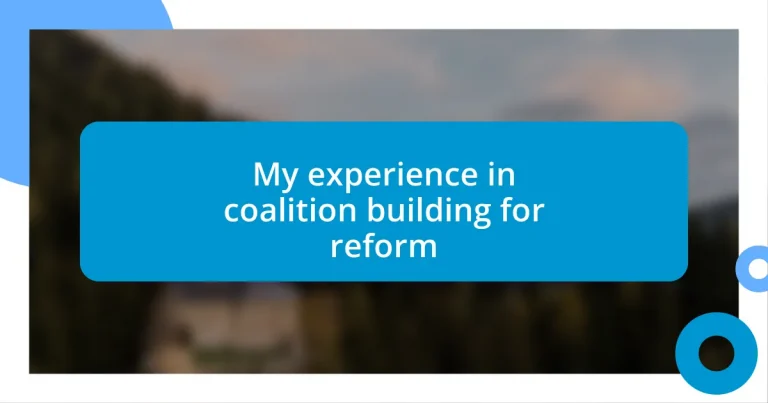Key takeaways:
- Successful coalition building relies on clear communication, inclusivity, and establishing shared goals to foster unity and creativity.
- Regular engagement strategies, such as check-ins and celebrating small victories, are essential for maintaining motivation and connection among members.
- Addressing challenges, such as differing resource access and trust issues, through vulnerability and open dialogue strengthens coalition ties and enhances collaboration.

Understanding coalition building
Coalition building is much more than just gathering people with similar goals; it’s about creating a shared vision rooted in trust and mutual respect. I remember my first coalition meeting: the energy in the room was palpable, but so was the tension. Everyone had strong opinions, and it made me wonder, how do we turn this passion into productive collaboration?
Understanding the diverse motivations and perspectives within a coalition is crucial. Take, for instance, a moment when a member voiced their frustrations about the pace of change. I recognized that their urgency came from personal experiences that fueled their commitment. It struck me that, without acknowledging these emotions, we risk losing valuable voices needed to drive effective reform.
A successful coalition requires ongoing communication and adaptability. I often found myself asking, “Are we truly considering everyone’s input?” It became clear that fostering an environment where all members feel valued fosters not just unity, but creativity as well. I learned that innovative solutions often emerge when people feel free to express their views.
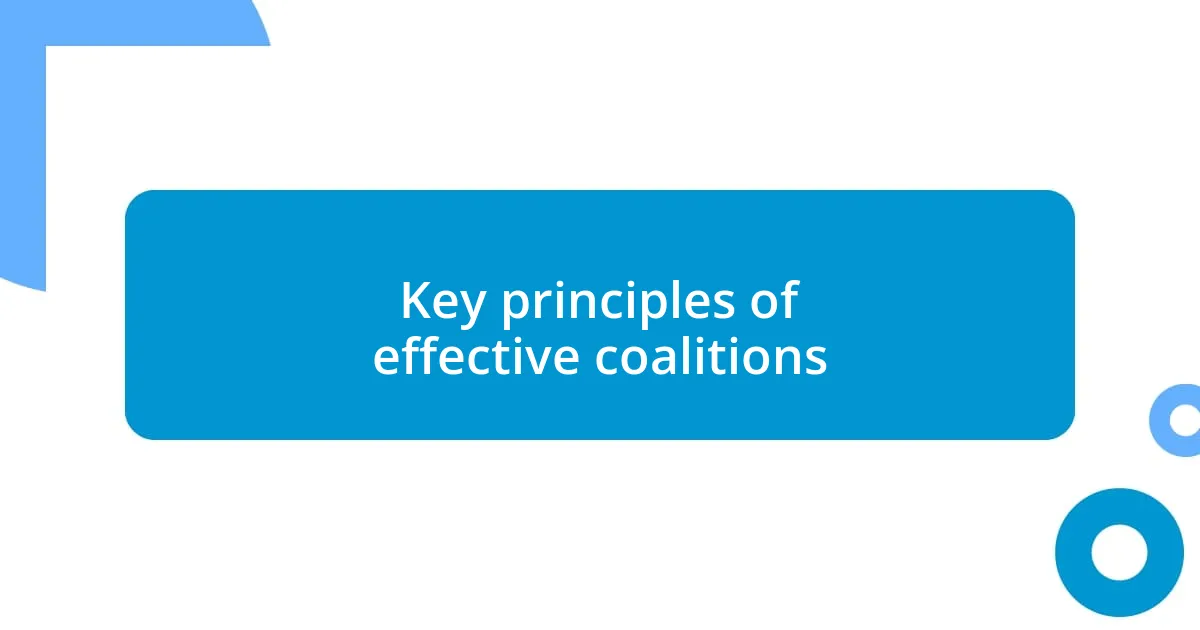
Key principles of effective coalitions
Building effective coalitions hinges on clear communication. I remember one specific instance where an unclear message led to misunderstandings among coalition members. By prioritizing consistent updates and open dialogue, we transformed confusion into collaboration, ensuring everyone felt informed and invested in our common goals.
Another essential principle is inclusivity. When I was part of a coalition tackling educational reform, I made it a point to invite voices from underrepresented communities. Their unique insights not only enriched our discussions but also inspired a deep sense of ownership. Witnessing this firsthand reminded me that when everyone feels they have a stake, the coalition becomes more resilient.
Lastly, establishing shared goals is vital for cohesion. In a previous effort, we took the time to craft a collective vision that resonated with all members. This process, which required patience and compromise, ultimately united us and fueled our drive toward reform. It’s a lesson I’ve kept close: a coalition thrives when all members are aligned in purpose and spirit.
| Key Principle | Description |
|---|---|
| Clear Communication | Ensures all members are informed and engaged, reducing misunderstandings. |
| Inclusivity | Brings diverse perspectives to the forefront, enriching discussions and promoting ownership. |
| Shared Goals | Aligns the coalition members towards a common vision, enhancing unity and motivation. |
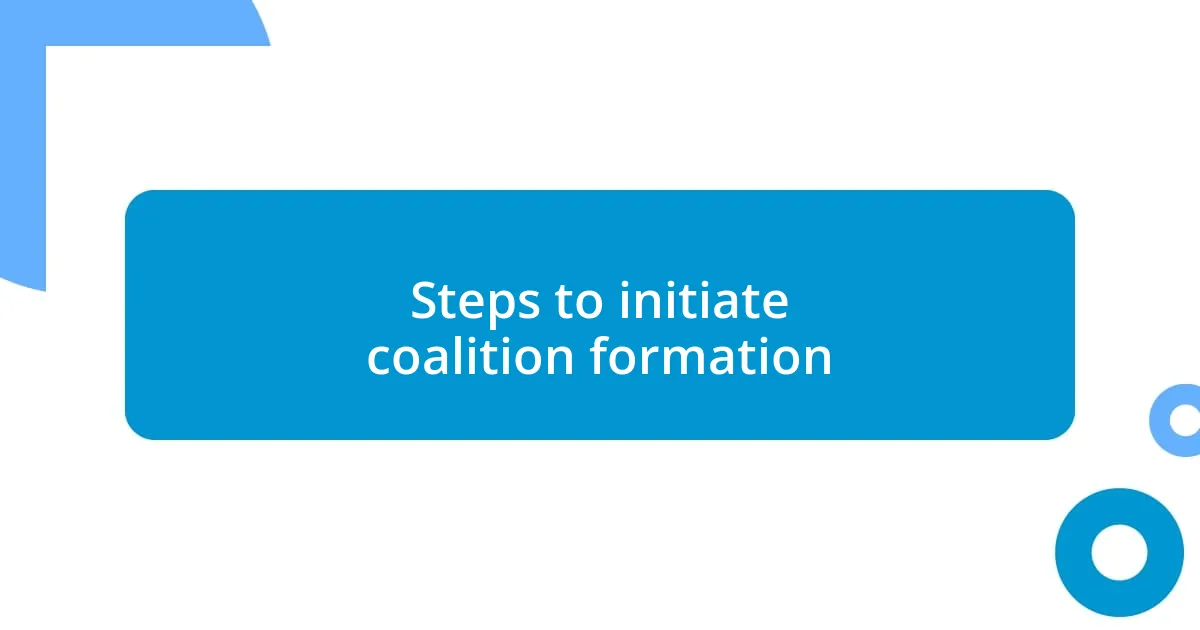
Steps to initiate coalition formation
Initiating a coalition can feel daunting, but I’ve learned that breaking it down into manageable steps makes the process much smoother. First, it’s vital to identify potential allies who share your vision. This step requires a bit of exploration and conversation. I once reached out to individuals in my network who I believed could support the cause. Our initial discussions laid the groundwork for more formal meetings, demonstrating that sometimes, the most genuine connections spark from casual conversations.
Here are some essential steps to initiate coalition formation:
- Define the Purpose: Clearly articulate what you aim to achieve together.
- Identify Key Stakeholders: Look for individuals or groups whose interests align with your objectives.
- Reach Out: Initiate conversations with potential members, sharing your vision and inviting their input.
- Facilitate Initial Meetings: Create spaces where members can voice their thoughts and begin building relationships.
- Establish Ground Rules: Set expectations for communication and collaboration from the get-go.
I vividly recall the first time I called for an initial meeting. My heart raced, mixing excitement with a bit of anxiety. I crafted a simple agenda, ensuring every participant felt heard. That initial gathering not only cemented our shared interests but also created a bond among us, reminding me that each coalition starts with a mixture of ambition and connection.
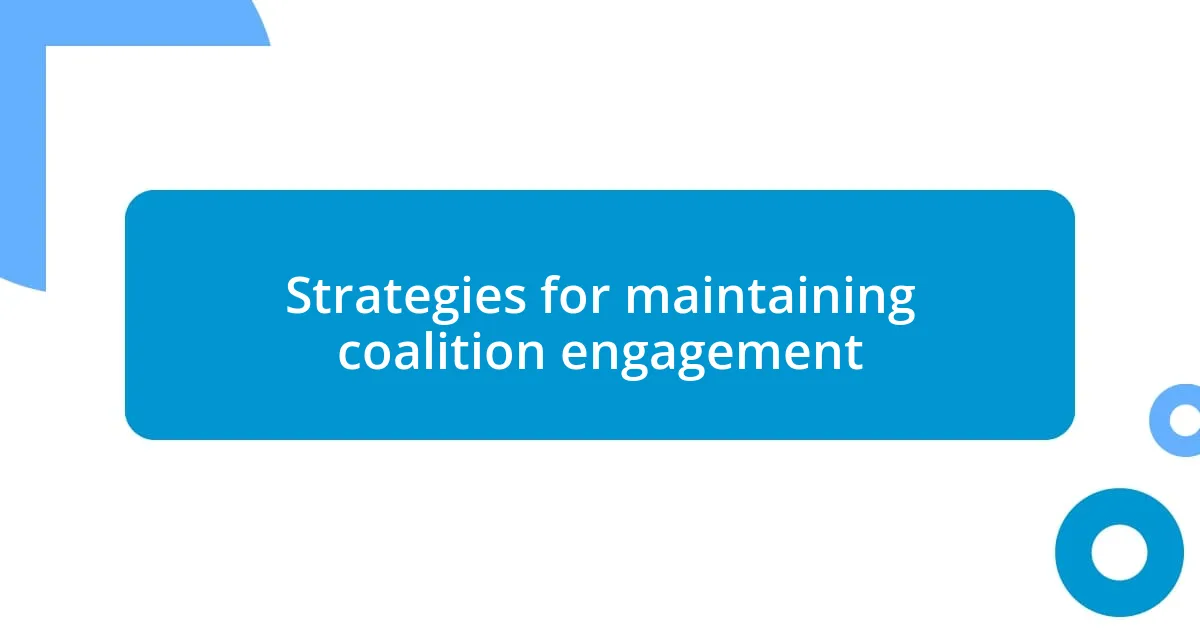
Strategies for maintaining coalition engagement
Maintaining engagement within a coalition is an ongoing process that necessitates intentional strategies. I often suggest regular check-ins, both formal and informal, to ensure everyone’s voice remains active. In one coalition I participated in, we set up bi-weekly coffee chats where we didn’t just discuss progress but also shared personal stories. This not only strengthened our bonds but also reignited our passion for the collective mission each time.
Another effective approach is leveraging technology. I’ve found that using a shared platform for updates and discussions helps keep everyone in the loop. I remember when we implemented a messaging app that allowed members to share successes, challenges, and even funny moments related to our work. It created a sense of camaraderie and accountability, making it easier for our coalition to stay energized and connected as we battled the inevitable ups and downs together.
Lastly, celebrating small victories is crucial. I can’t stress enough how significant it is to acknowledge achievements, no matter how minor they may seem. When our coalition successfully lobbied for a small policy change, we hosted a celebratory event. It reminded us all of the power of our collaboration. It begs the question: how often do we take the time to reflect on our progress? I believe it’s essential; it instills a sense of purpose and keeps everyone motivated for the journey ahead.

Overcoming challenges in coalitions
Navigating the challenges in coalition-building can be quite a trip. I remember a moment when disagreement arose over strategic directions. It felt like walking a tightrope, balancing different perspectives while keeping our collective goals in sight. I initiated a dialogue where each member could express their thoughts without judgment. Surprisingly, what started as a potential fracture turned into a productive brainstorming session that fostered deeper understanding among us all.
Another hurdle I faced was maintaining momentum during periods of uncertainty. There were times when the energy dipped, and participation waned. In those moments, I learned the importance of vulnerability. I openly shared my concerns and asked members how they were feeling about our progress. This simple act of transparency helped us reconnect to our shared vision and reignited the passion within the group. Have you ever found that vulnerability can be a source of strength in a coalition? I certainly have.
Resource disparities can also create tension. During one initiative, some members had more access to funding and support than others. This imbalance led to feelings of inadequacy, affecting participation. To address this, I organized a resource-sharing session where everyone could offer and seek assistance. This not only leveled the playing field but also reinforced our commitment to collaboration, proving that effective coalitions thrive on the principles of equity and mutual support. Why does it often take a challenge to remind us of the strength in togetherness? For me, these moments are when the real magic happens.
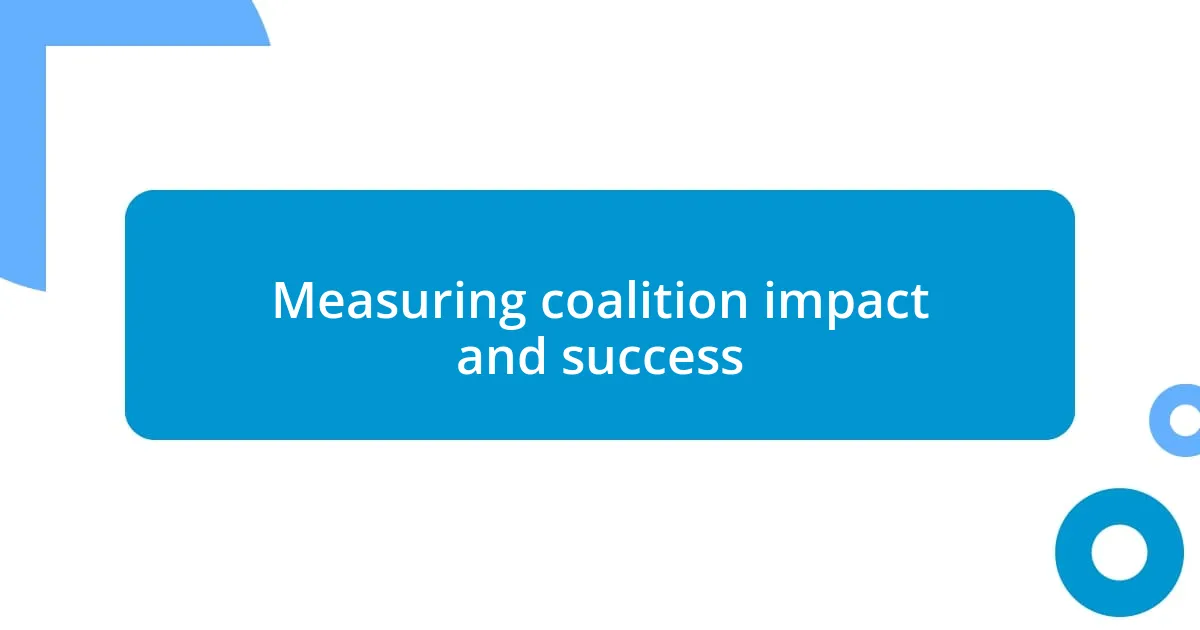
Measuring coalition impact and success
Measuring the impact and success of a coalition can often feel nuanced and subjective. During one of my initiatives, we developed a set of clear metrics to gauge our progress and influence. By analyzing both qualitative feedback and quantitative data—such as changes in policy or community engagement—we gained a holistic view of our coalition’s effectiveness. It made me wonder, how often do we take a moment to assess our impact rather than just pushing forward?
In my experience, storytelling is a powerful tool for showcasing success. After we achieved a significant policy reform, I encouraged each member to share their individual experiences and the personal impact of our work. It wasn’t just about the numbers; hearing how our efforts transformed lives reminded us all of our collective mission. I couldn’t help but feel a surge of pride; these stories became our testimonials, illustrating the real-world change we were capable of creating. How can we capture those stories to better understand our coalition’s legacy?
Engaging stakeholders throughout this evaluation process is crucial, too. When we conducted our impact assessments, I made a point to include feedback from community members and non-member allies. This openness fostered deeper relationships and offered insights I hadn’t considered. Some of those voices shared the most resonant stories of change, prompting me to think: aren’t the perspectives of those we aim to impact the most vital in assessing our success? Through this inclusive lens, I believe we not only refine our strategies but also strengthen the foundation of our coalition.
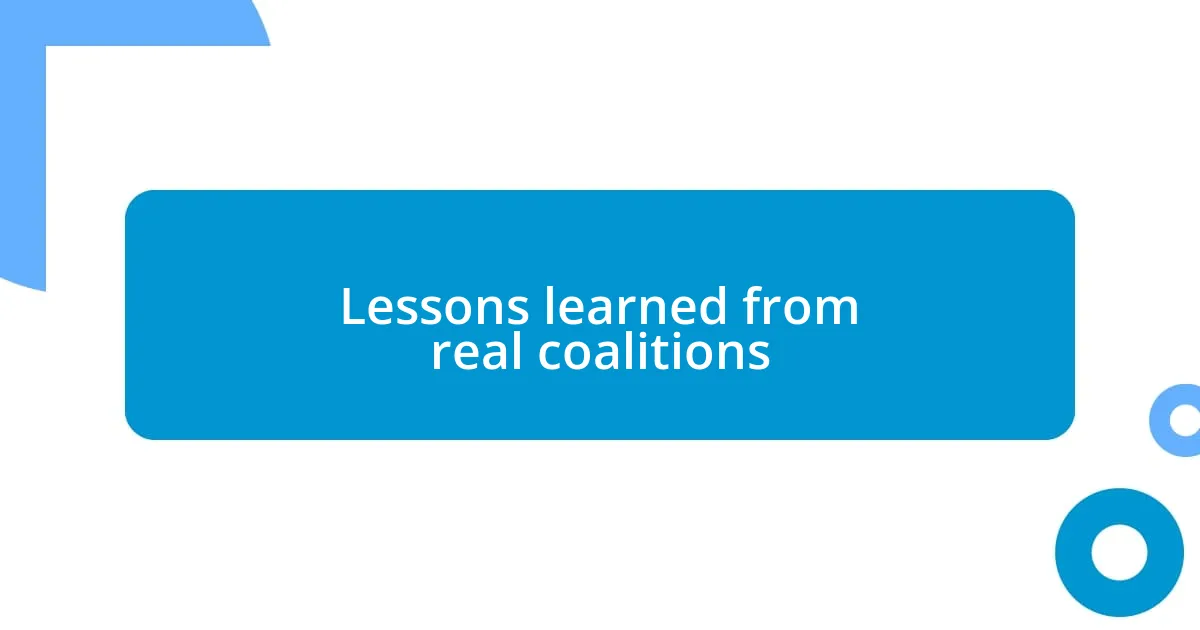
Lessons learned from real coalitions
Coalitions are often a tapestry of diverse interests, and I learned early on that clarity is essential. In one instance, we faced confusion about our roles, leading to overlapping efforts and frustration. To address this, I facilitated a workshop, encouraging open dialogue about expectations and responsibilities. It was eye-opening; once everyone had a clear understanding, not only improved productivity, but a sense of ownership emerged among members. Isn’t it fascinating how a little structure can unleash creativity and commitment?
Building trust is another cornerstone of successful coalitions. I recall a particularly challenging period when skepticism crept in among members, casting shadows over our objectives. Instead of glossing over this tension, I organized regular check-ins, creating space for honest conversations about our trust issues. By allowing vulnerabilities to surface, we took steps toward healing. Reflecting on that experience, I’ve come to realize that these moments of authenticity can transform hesitance into strong alliances. Have you ever noticed how shared struggles can forge unexpected bonds?
Lastly, I discovered the power of shared stories in creating cohesion. During one of our campaigns, I encouraged coalition members to share their personal motivations for getting involved. The response was incredible; hearing those raw, heartfelt accounts not only deepened our connection but ignited a renewed sense of purpose. It made me question, how often do we neglect to share our ‘why’? By weaving our narratives together, we didn’t just build a coalition; we created a supportive community grounded in a shared vision and mutual respect.












